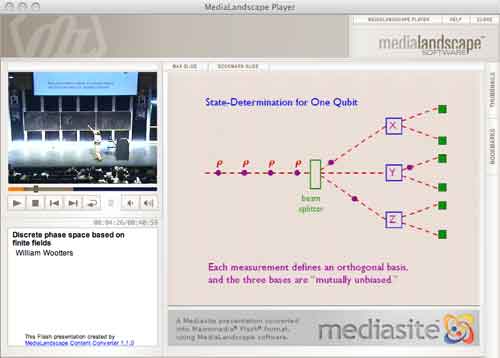MUBs (for Mutually Unbiased Bases) are quite popular at the moment. Kea is running a mini-series Mutual Unbias as is Carl Brannen. Further, the Perimeter Institute has a good website for its seminars where they offer streaming video (I like their MacromediaFlash format giving video and slides/blackboard shots simultaneously, in distinct windows) including a talk on MUBs (as well as an old talk by Wootters).

So what are MUBs to mathematicians? Recall that a d-state quantum system is just the vectorspace $\mathbb{C}^d $ equipped with the usual Hermitian inproduct $\vec{v}.\vec{w} = \sum \overline{v_i} w_i $. An observable $E $ is a choice of orthonormal basis ${ \vec{e_i} } $ consisting of eigenvectors of the self-adjoint matrix $E $. $E $ together with another observable $F $ (with orthonormal basis ${ \vec{f_j} } $) are said to be mutally unbiased if the norms of all inproducts $\vec{f_j}.\vec{e_i} $ are equal to $1/\sqrt{d} $. This definition extends to a collection of pairwise mutually unbiased observables. In a d-state quantum system there can be at most d+1 mutually unbiased bases and such a collection of observables is then called a MUB of the system. Using properties of finite fields one has shown that MUBs exists whenever d is a prime-power. On the other hand, existence of a MUB for d=6 still seems to be open…
The King’s Problem (( actually a misnomer, it’s more the poor physicists’ problem… )) is the following : A physicist is trapped on an island ruled by a mean
king who promises to set her free if she can give him the answer to the following puzzle. The
physicist is asked to prepare a d−state quantum system in any state of her choosing and give it
to the king, who measures one of several mutually unbiased observables on it. Following this, the physicist is allowed to make a control measurement
on the system, as well as any other systems it may have been coupled to in the preparation
phase. The king then reveals which observable he measured and the physicist is required
to predict correctly all the eigenvalues he found.
The Solution to the King’s problem in prime power dimension by P. K. Aravind, say for $d=p^k $, consists in taking a system of k object qupits (when $p=2l+1 $ one qupit is a spin l particle) which she will give to the King together with k ancilla qupits that she retains in her possession. These 2k qupits are diligently entangled and prepared is a well chosen state. The final step in finding a suitable state is the solution to a pure combinatorial problem :
She must use the numbers 1 to d to form $d^2 $ ordered sets of d+1 numbers each, with repetitions of numbers within a set allowed, such that any two sets have exactly one identical number in the same place in both. Here’s an example of 16 such strings for d=4 :
11432, 12341, 13214, 14123, 21324, 22413, 23142, 24231, 31243, 32134, 33421, 34312, 41111, 42222, 43333, 44444
Here again, finite fields are used in the solution. When $d=p^k $, identify the elements of $\mathbb{F}_{p^k} $ with the numbers from 1 to d in some fixed way. Then, the $d^2 $ of number-strings are found as follows : let $k_0,k_1 \in \mathbb{F}_{p^k} $ and take as the first 2 numbers the ones corresponding to these field-elements. The remaning d-2 numbers in the string are those corresponding to the field element $k_m $ (with $2 \leq m \leq d $) determined from $k_0,k_1 $ by the equation
$k_m = l_{m} * k_0+k_1 $
where $l_i $ is the field-element corresponding to the integer i ($l_1 $ corresponds to the zero element). It is easy to see that these $d^2 $ strings satisfy the conditions of the combinatorial problem. Indeed, any two of its digits determine $k_0,k_1 $ (and hence the whole string) as it follows from
$k_m = l_m k_0 + k_1 $ and $k_r = l_r k_0 + k_1 $ that $k_0 = \frac{k_m-k_r}{l_m-l_r} $.
In the special case when d=3 (that is, one spin 1 particle is given to the King), we recover the tetracode : the nine codewords
0000, 0+++, 0—, +0+-, ++-0, +-0+, -0-+, -+0-, –+0
encode the strings (with +=1,-=2,0=3)
3333, 3111, 3222, 1312, 1123, 1231, 2321, 2132, 2213
Leave a Comment